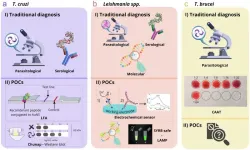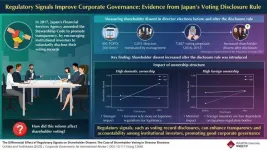(Press-News.org) Immune therapy has transformed how cancer is treated, but many tumors continue to evade these treatments, thanks to their resemblance to healthy tissue.
Now, researchers at UC San Francisco have found that some cancers, like deadly brain cancer (glioma), make unique, jumbled proteins that make them stand out. These newly recognized cancer-specific proteins, or antigens, could speed the development of potent immunotherapies that recognize and attack hard-to-treat tumors.
The study, which was supported through grants from the National Institutes of Health, appears in Nature on Feb. 19.
The newly discovered antigens were the product of mistakes in RNA splicing, which controls how RNA molecules – the blueprints for proteins – are pieced together from smaller parts. The study found that in cancers of the brain, prostate, liver and colon, among others, the tumors spliced together bits of RNA to create new forms that had never been seen before, and which were absent in healthy tissues.
Some of these new RNAs produced antigens that attached to the surface of tumor cells, creating an entry for immune therapy. The researchers then engineered immune T-cells to recognize these antigens and were able to destroy glioma in the lab.
Such antigens from alternative RNA splicing could vastly expand the number of targets available for immunotherapy – and the options available to patients in need of a cure.
“We think these first antigens could be actionable in the near future, leading to new therapies for glioma patients,” said Hideho Okada, MD, PhD, professor of neurosurgery at UCSF and co-corresponding author of the paper. “But they are the tip of the iceberg and we’re excited to look into many more from the data we generated.”
Fishing antigens from a sea of RNA
Precision medicine today relies on either drugs that disable the mutant proteins that cause cancer or on the immune cells that track down cancer-related antigens. But many tumors don’t have such mutant proteins or antigens. Even if they do, those targets might not cover all of a tumor.
“One of the reasons we think a lot of glioma therapies fail is that they only target one part of the tumor. The rest of the tumor escapes unscathed,” said Joe Costello, PhD, professor of neurosurgery at UCSF and co-corresponding author of the paper. “These new antigens lift us over that major hurdle of brain tumor heterogeneity.”
To hunt for new targets for cancer therapies, Darwin Kwok, PhD, focused on RNA splicing, which sometimes produces several versions of a protein based on a single gene.
“Many cancer therapies today are based on unique DNA mutations found in tumors, but we suspected that tumors might also have altered RNA splicing leading to new cancer-specific antigens,” said Kwok, who is a PhD graduate from the Okada and Costello labs, current UCSF medical student, and first author of the paper.
Kwok pored through RNA sequencing data from thousands of tumors held by The Cancer Genome Atlas, a program at the National Cancer Institute. He homed in on uniquely-spliced RNA messages (mRNAs) that were consistently found in multiple biopsies per tumor and in multiple patients. The tumors came from prostate, liver, colon, stomach, kidney, and lung cancers.
He also teamed up with the UCSF Brain Tumor Center to look for these mRNAs in glioma samples donated by 51 UCSF patients. The researchers obtained up to ten biopsies per tumor, kept track of where in each tumor each biopsy had come from, and again looked for unusual mRNAs.
From this broad analysis, the team found nearly 1,000 cancer-specific mRNAs, common across tumors, cancer types, and patients, that had never been documented. None were ever found in healthy tissue.
Predicting the best targets for new therapies
Not every mRNA becomes a protein. Not every protein is attached to the cell surface as an antigen. And not every antigen can be recognized by the immune system. So, the researchers modeled what might happen to each of these mRNAs on the hopeful path to becoming a viable target for immunotherapy.
They ended up with 32 antigen candidates, all borne of cancer’s alternative RNA splicing, that showed promise as an immunotherapy target, and chose the top four for more rigorous testing. These four antigens had similar shapes to other antigens known to provoke an immune attack.
The researchers first programmed cells to display the four antigens. Then they challenged immune cells obtained from healthy donor blood to react to the antigens. The experiment revealed receptors on these natural immune cells that reliably detected the cancerous antigens – a crucial step toward engineering them into a potential therapy.
The chances of finding these immune receptors in donated blood were remote – “like one in five or 10 million,” according to Okada. But the team struck gold. For two of the top four antigens, the experiment unearthed complementary immune receptors in two different donors.
Making a new immunotherapy from scratch
Laboratory T-cells were programmed to make these immune receptors and unleashed on glioma cells in petri dishes. The cancer cells were no match for these specially-trained immune cells and were quickly eliminated.
The scientists are now testing this approach in animal models of cancer and hope to bring them quickly to patients if successful. There are many more antigens worthy of follow-up, including the 28 antigens that didn’t make the final cut in this study, and countless others.
The team can only speculate why so many cancers make the same handful of jumbled proteins. It could be a mere artifact of cancer biology. In the meantime, a new front has been opened in treating cancer.
“This advance for cancer patients is the epitome of collaboration at UCSF, from computational modeling to laboratory validation and new techniques in brain surgery,” Okada said. “It’s exactly what the field needs to overcome the most stubborn cancer cases and bring relief to our patients.”
Authors: Christopher Klebanoff, MD, Memorial Sloan Kettering Cancer Center, is also co-corresponding author. Other UCSF authors are Nicholas O. Stevers, PhD, Takahide Nejo, MD, PhD, Maggie Colton Cove, Lee H. Chen, MD, PhD, Jangham Jung, PhD, Kaori Okada, Senthilnath Lakshmanachetty, PhD, Marco Gallus, MD, MS, Abhilash Barpanda, PhD, MSc, Chibo Hong, PhD, Gary K.L. Chan, Jerry Liu, Samuel H. Wu, Emilio Ramos, MD, PhD, Akane Yamamichi, MD, PhD, Payal Watchmaker, PhD, Hirokazu Ogino, MD, PhD, Atsuro Saijo, MD, PhD, Aidan Du, Nadia Grishanina, James Woo, Aaron Diaz, PhD, Shawn Hervey-Jumper, MD, Susan M. Chang, MD, Joanna J. Phillips, MD, PhD, and Arun P. Wiita, MD, PhD. For all authors see the paper.
Funding: This study was supported, in part, by National Institutes of Health (NIH) grants R35NS105068, R01CA222965, NCI 2P50CA097257, NCI P50CA097257, NCI P01CA118816, T32GM008568, 5T32CA151022, R37 CA259177, R01CA269733, R01 CA286507, P30 CA008748, and NCI 1R50CA274229. For all funding and disclosures see the paper.
About UCSF: The University of California, San Francisco (UCSF) is exclusively focused on the health sciences and is dedicated to promoting health worldwide through advanced biomedical research, graduate-level education in the life sciences and health professions, and excellence in patient care. UCSF Health, which serves as UCSF's primary academic medical center, includes top-ranked specialty hospitals and other clinical programs, and has affiliations throughout the Bay Area. UCSF School of Medicine also has a regional campus in Fresno. Learn more at ucsf.edu, or see our Fact Sheet.
###
Follow UCSF
ucsf.edu | Facebook.com/ucsf | YouTube.com/ucsf
END
Jumbled proteins paint a bold target on the backs of brain tumors
UCSF scientists find a trove of new targets for cancer immunotherapy in cancer’s unique version of RNA splicing
2025-02-19
ELSE PRESS RELEASES FROM THIS DATE:
Liver injury in immune Stevens-Johnson Syndrome and toxic epidermal necrolysis: Five new classification types
2025-02-19
Introduction
First identified by Stevens and Johnson in 1922, SJS and TEN are now recognized as disorders with a continuum of severity, from milder forms (SJS) to the most severe (TEN). SJS/TEN is associated with multiple etiological factors, most notably drug-induced liver injury (DILI), making the identification of the responsible agent crucial for patient management. However, previous studies have lacked uniformity in diagnostic approaches, limiting the ability to draw clear conclusions about causality.
Epidemiology
The incidence of SJS/TEN varies across regions, with notable differences between studies. For instance, ...
MSU study: Socioeconomic factors, unpredictability complicate diagnosis of episodic disabilities, like epilepsy
2025-02-19
Any patient suffering from new or worsening medical symptoms hopes for a relatively quick and accurate diagnosis.
However, for many people with episodic disabilities — periodic or intermittent conditions like migraines, lupus, Crohn’s disease and epilepsy, in which the presence and severity of symptoms fluctuate — a swift diagnosis is not guaranteed.
New research from Michigan State University focuses on diagnostic delays experienced by people with one such condition: epilepsy, a neurological disorder characterized by unpredictable seizures that affects over 3 million people in the United States and 50 million worldwide.
“Epilepsy ...
Revolutionizing tropical disease treatment: The future of conjugating nanomaterials with drugs
2025-02-19
Introduction
Neglected Tropical Diseases (NTDs) remain a significant health burden in tropical and subtropical regions, with limited treatment options and diagnostic capabilities. These diseases are often neglected in research and policy, yet they contribute to high mortality and morbidity worldwide. Nanotechnology, particularly the conjugation of nanomaterials with drugs, presents an innovative approach to improving both the diagnosis and treatment of these diseases. Nanomaterials have unique properties that allow for enhanced drug delivery, ...
Improving quality of life and end-of-life care: Standardizing goals of care notes in EHRs
2025-02-19
INDIANAPOLIS – It is important that a healthcare team is aware of and understands a patient’s goals of care, both medical and personal. But that information, if documented, typically is not placed in a standardized location and is difficult to find within a patient’s voluminous electronic health record (EHR).
A new study by researchers from Regenstrief Institute, the Indiana University School of Medicine and Indiana University Health presents the standardized goals of care note they developed, deployed and evaluated as a quality improvement initiative at ...
Taking vitamin E during pregnancy may decrease peanut allergy in children
2025-02-19
New research found that supplementing maternal diet with α-tocopherol, a form of vitamin E, can reduce the development of food allergy and anaphylaxis in newborn mice.
The prevalence of food allergy in children increased 50% from 2007 to 2021 in the United States (US), with the incidence of peanut allergy tripling in that time. This new study, published in The Journal of Immunology, shows the potential for α-tocopherol in prenatal vitamins during pregnancy and lactation to address this alarming increase and reduce development of food allergy early in life.
The study found that ...
AI in retail: how to spark creativity and improve job satisfaction
2025-02-19
Artificial intelligence (AI) is reshaping workplaces by streamlining routine tasks and boosting efficiency, particularly in retail, where innovation is essential for maintaining a competitive edge. Beyond automation, AI supports employee creativity by offering valuable insights and allowing them to focus on innovative tasks. However, research is limited on how AI service quality impacts employees in retail industries, making this an important area to explore.
Researchers from Florida Atlantic University and Hanyang University in Seoul, South Korea, examined how perceived AI service quality influences retail employees’ ...
1 in 5 older adults get infections after heart surgery, and women have a 60% higher risk
2025-02-19
One in five older adults gets an infection up to six months after heart surgery — with women far more likely to develop one, according to studies led by Michigan Medicine.
The two studies examined thousands of cases involving Medicare beneficiaries who underwent coronary artery bypass grafting, also known as CABG or heart bypass, or aortic valve replacement.
Women had 60% greater odds of developing postoperative infections, the three most common being urinary tract, pneumonia and sepsis.
Black patients also had higher rates of overall infection (28%) ...
New funding to support food security, economic resiliency
2025-02-19
DALLAS, Feb. 19, 2025 — The conditions in which we are born, live, learn, work, play and age — the social drivers of health — are better predictors of health and life expectancy than our genetic code. In communities nationwide, people living in locations just a handful of miles apart can have a dramatic difference in life expectancy.
To help level the playing field, the Grubhub Community Fund awarded the American Heart Association® Social Impact Funds a $2 million grant to support food security, technology innovation and economic resiliency in New York City and Chicago.
“We are grateful ...
All generic drugs are not equal, study finds
2025-02-19
COLUMBUS, Ohio – Generic drugs manufactured in India are linked to significantly more “severe adverse events” for patients who use them than equivalent drugs produced in the United States, a new study finds.
These adverse events included hospitalization, disability, and in a few cases, death. Researchers found that mature generic drugs, those that had been on the market for a relatively long time, were responsible for the finding.
The results show that all generic drugs are not equal, even though patients are often told that they are, said John Gray, co-author of the study and professor of operations at The Ohio State University’s ...
Enhancing shareholder accountability: Lessons from Japan’s corporate governance reforms
2025-02-19
Shareholders play a crucial role in corporate governance by voting on key decisions in the companies they invest in. To enhance transparency, regulatory bodies worldwide—such as government agencies and stock exchanges—are increasingly implementing guidelines to hold institutional investors accountable for their voting behavior and ensure they fulfill their fiduciary duties.
A study published in the journal Corporate Governance: An International Review on 22 January 2025 demonstrates that these regulations, even if non-binding, can encourage institutional investors to play a more active role and improve corporate governance. The study, conducted ...
LAST 30 PRESS RELEASES:
The perfect plastic? Plant-based, fully saltwater degradable, zero microplastics
Bias in data may be blocking AI’s potential to combat antibiotic resistance
Article-level metrics would provide more recognition to most researchers than journal-level metrics
Satiety’s little helper: Protein that supports appetite regulating protein identified
UF dives deep into predicting storm damage with computer models
A stormy ocean voyage yields insights on the global carbon cycle
Scientists identify first non-coding gene that controls cell size
Demonstration of altermagnetism in RuO₂ thin films -- A new magnetic material for the AI era
Penn researchers awarded $25M to conduct trial using smartphones to fight heart disease
PCORI awards funding for new patient-centered healthcare research
Exploring the origins of the universe: 145 low-noise amplifiers complete ALMA telescopes
Empress cicada wings help illuminate molecular structure
Using sound waves to detect helium
Time burden in patients with metastatic breast and ovarian cancer from clinic and home demands
Researchers discover bias in AI models that analyze pathology samples
Scientists ID potential way to prevent brain injuries from triggering Alzheimer's
MASTER 2nd Open Call: Execution period kick-off
Algae for health in food and pharma
Advanced microrobots driven by acoustic and magnetic fields for biomedical applications
Chicago health information leader recognized for raising CPR readiness and blood pressure awareness
The Intimate Animal, a new book from Kinsey Institute Executive Director Dr. Justin Garcia
When blue-collar workers lose union protection, they try self-employment
New video dataset to advance AI for health care
MEA-based graph deviation network for early autism syndrome signatures in human forebrain organoids
New modeling approach sheds light on rare gut disease
Study documents potentially hazardous flame retardants in firefighter gear
Can certain bacteria regulate aging of the immune system and its related alterations?
AI model helps diagnose often undetected heart disease from simple EKG
There are fewer online trolls than people think
Cell membrane fluctuations produce electricity
[Press-News.org] Jumbled proteins paint a bold target on the backs of brain tumorsUCSF scientists find a trove of new targets for cancer immunotherapy in cancer’s unique version of RNA splicing


